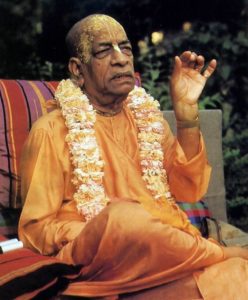In the personal Guru Pranama Mantra of Srila Prabhupada we find the word “nirvisesa”, meaning “mayavada” or the philosophy of illusion.
Mayavada is a philosophy much akin to the one called “advaitavada” and also to the bauddhavada, or sunyavada, the philosophy of voidism. Pracchannaṁ bauddham, Mayavada is covered Buddhism (Caitanya Caritamrita Adi-lila 7.110).
Today we are going to analyze the word nir-visesa. Not a complete essay but only a small hint.
The prefix nir means without, not, destitute of etcetera. It’s actually one of the variation of the prefix nis, which can became nih, nir, nish, nii etc depending from the grammatical value.
The word visesa may mean a number of things, amongst which we find “quality”, “attribute”, “modification”, “property”, “special” etc.
Therefore the word nirvisesa means without quality and it’s a stronghold of impersonalists who say that the Supreme Entity is deprived of quality and that is only an indiffentiated One.
One of the qualities of a great spiritual master is to be able to defeat nirvisesa’s misleading philosophy.
We hold that the Supreme Lord has visesa, or qualities, and that those are not material but spiritual. We also hold that there is no difference between the Lord qualities and He Himself, like (a sruti says) there is no difference between a snake and his coils.
There are a number of srutis (vedic statements) that apparently support nirvisesa. For instance:
– tat tvam asi, you are that, (Chandogya Upanishad 6.8.7 of the Sama Veda)
– aham brahmāsmi, I am Brahman, (Brihadaranyaka Upanishad 1.4.10 of the Yajur Veda)
– sarvam khalv idaṁ brahma, everything, both matter and spirit, is non-different from the Supreme Personality of Godhead who is the Supreme Brahman. (Chāndogya Upaniṣad 3.14.1.)
– ayam ātmā brahma – “This Self (Atman) is Brahman” (Mandukya Upanishad 1.2 of the Atharva Veda)
And so on.
However we find in the same srutis also the exact opposite. Srila Prabhupada explain this phenomenon in these terms:
“For the sake of those whose realization of spiritual life is only gradually awakening, the Upaniṣads sometimes speak in general terms of ātmā or Brahman, not openly distinguishing the difference between the superior and inferior souls, the Paramātmā and jīvātma. But often enough they describe this duality in unequivocal terms.”
And then he quotes the famous verse dva suparna sayuja sakhaya.
The complete verse recites in this way:
dvā suparṇā sayujā sakhāyā
samānaṁ vṛkṣaṁ pariṣasvajāte
tayor anyaḥ pippalaṁ svādv atty
anaśnann anyo ’bhicākaśīti
“Two companion birds sit together in the shelter of the same pippala tree. One of them is relishing the taste of the tree’s berries, while the other refrains from eating and instead watches over His friend.”
(Śvetāśvatara Upaniṣad 4.6)
Here the difference between Paramatma and atma is clear.
Sri Isopanisad (verse 15), says:
hiraṇmayena pātreṇa
satyasyāpihitaṁ mukham
tat tvaṁ pūṣann apāvṛṇu
satya-dharmāya dṛṣṭaye
“O my Lord, sustainer of all that lives, Your real face is covered by Your dazzling effulgence. Kindly remove that covering and exhibit Yourself to Your pure devotee.”
The word mukham means “face”. So the Lord has a face and He covers it with his dazzling light (hiraṇmayena pātreṇa).
Also tvam is a personal pronoun meaning “you”. If in a phrase there a “you” there must also be an “I”, an “it” etc.
Therefore on the strenght of this Sruti we have proven the plurality of existing entity, all secondary to the Supreme Lord.
And so on.
Actually Mayavadis try to explain Srutis in a secondary sense (laksana). They say the Supreme Lord is nirguna, without qualities and never Saguna, with qualities.
We say that He is Nirguna meaning without material qualities, and at the same time Saguna, meaning “with spiritual qualities”. There is nothing in the two words to suggest different interpretation and not even in any scriptural context.
Therefore the Lord owns visesas or recognizable transcendental qualites.
What differentiate Mayavadis from Bhagavatas is that the formers can’t never explain contradictions in Srutis (which are only apparent), while Bhagavatas can easily reconcile them.
– Manonatha Dasa (ACBSP)
23 dic 2019




Leave a Reply